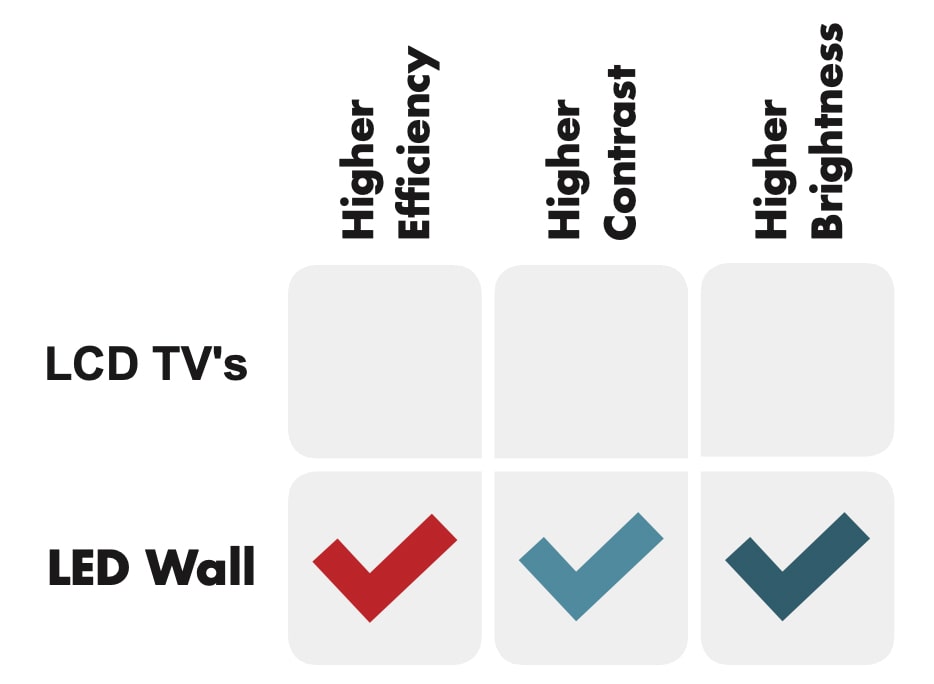
LED video walls and high-resolution displays are becoming increasingly popular due to their superior technology and image quality. Compared to traditional LCD TV screens, LED video walls and high-resolution displays offer a wide range of advantages including higher brightness levels, sharper image quality, wider viewing angles, and better energy efficiency. In this blog post, we will explore the advantages of LED Video walls and high-resolution displays over LCD TV screens.
What are LED video walls and hi-resolution displays?
LED video walls and hi-resolution displays are advanced technologies used for displaying visual content in a variety of settings. LED video walls consist of multiple LED panels that are seamlessly connected to create a large display screen. These panels use LEDs as pixels to emit bright, vibrant colors and provide high-resolution images. Hi-resolution displays refer to screens that have a higher pixel density, resulting in sharper and more detailed images. These displays can be LCD (liquid crystal display) or OLED (organic light-emitting diode) screens. They are commonly used in smartphones, tablets, computer monitors, and televisions.
While both LED video walls and hi-resolution displays offer superior image quality compared to LCD TVs, they have different applications. LED video walls are typically used for large-scale installations, such as in stadiums, concert venues, control rooms, and outdoor advertising. They offer a wide viewing angle, excellent color reproduction, and high brightness levels, making them suitable for capturing the attention of a large audience. On the other hand, hi-resolution displays are more suitable for personal and small-scale use. They are commonly found in home entertainment systems, conference rooms, gaming monitors, and professional editing suites. These displays provide exceptional clarity and detail, allowing users to enjoy a more immersive visual experience.
Differences between LED video walls, hi-resolution displays, and LCD TV screens
LED video walls can be arranged in any size and shape. These panels are modular and can be easily connected to create a large, seamless video display. In contrast, hi-resolution displays are standalone displays that are available in different sizes and resolutions. They offer higher resolution than LCD TV screens, making them ideal for applications where high-quality visuals are important.

LCD TV screens are common in households and offices because of their affordability and convenience. They are great for personal use but cannot match the image quality of hi-resolution displays or LED Video Walls. The main difference between LCD TVs and LED Video Walls is the way the images are displayed. LCD TVs use backlights to light up pixels, while LED Video Walls use LEDs as individual pixels. This allows LED Video Walls to offer better color accuracy, higher brightness, and contrast compared to LCD TVs.Hi-resolution displays are an ideal option for applications where image quality is paramount, such as advertising, presentations, and conferences. They offer superior resolution and brightness, which can make a significant difference in image quality, especially for small text and fine details.
When comparing LED Video Walls vs. LCD TVs, one of the key differences is the flexibility in size and shape. LED Video Walls can be customized to fit any space, whether it's a small corner or a large exhibition hall. LCD TVs, on the other hand, are limited by their fixed size and shape options. Another difference is the image quality. LED Video Walls offer better color accuracy and higher brightness, which is essential for displaying vibrant visuals. LCD TVs, while convenient and affordable, often struggle to match the image quality of LED Video Walls.
Additionally, LED Video Walls are designed for commercial use and are built to be durable and reliable. They can withstand continuous operation for extended periods without any issues. LCD TVs, although suitable for personal use, may not have the same level of durability and reliability as LED Video Walls.

Overall, the choice between LED Video Walls and LCD TVs depends on the specific needs of the application. If high-resolution visuals and flexibility in size and shape are important, then LED Video Walls are the better option.
Advantages of hi-resolution displays over LCD TV screens
There are numerous advantages that hi-resolution displays have over LCD TV screens, making them a preferred choice for businesses looking for top-quality displays. Firstly, hi-resolution displays offer better picture quality due to their superior pixel density. This means that images and videos appear sharper, clearer, and more vibrant on hi-resolution displays. Additionally, hi-resolution displays offer better viewing angles and color accuracy, ensuring that content is easily visible from different positions and under different lighting conditions.

Another advantage of hi-resolution displays is their flexibility. They come in a variety of sizes and can be customized to fit specific spaces and requirements. This flexibility is particularly beneficial for businesses that need displays for non-standard spaces or need to combine multiple displays into one seamless image, as is the case with LED Video Walls vs. LCD TVs.
Lastly, hi-resolution displays offer superior reliability and durability compared to LCD TV screens. They are designed for commercial use and are built to withstand constant use and environmental conditions such as temperature and humidity.




